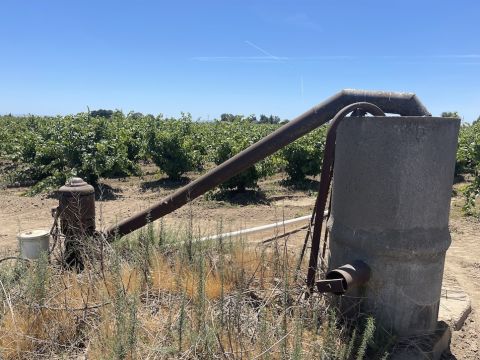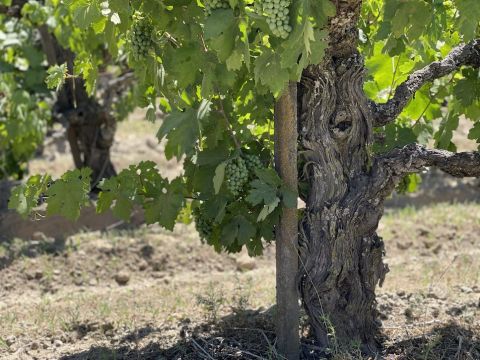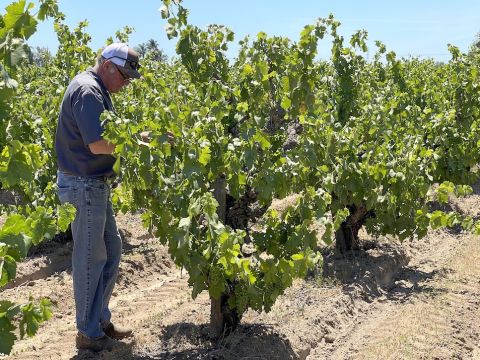Ray Road
We were in the back of a bus, circling a roundabout in Dijon, France. Tears welled in her eyes as she told me about her family’s old vine Zinfandel. 2019 was looking like a difficult year for the grape market in Lodi, California, and the old vines might be ripped up before she returned home to see them again.
It wasn’t the first time the vines’ future was being debated, and it wouldn’t be the last. But they were her family’s legacy, and she was determined to save them. She just needed more time.
The Fourth Generation
I met Jacylyn Stokes in 2018, when we were both MBA students at the Burgundy School of Business. Jacylyn was born into a family of grape growers in Lodi, California. She never intended to stay there, though. A study abroad trip to Barcelona, undergraduate studies at the University of Washington, then years in finance and global logistics kept Jacylyn in Seattle, 800 miles away from her family and their acres of vines.
Eventually, her roots started calling her back. To get herself ready, Jacylyn moved to France to earn an MBA in Wine & Spirits.
Nearly three years later, after our shared experience moving abroad and changing careers, Jacylyn and I still talk almost daily. Since France, we’ve been living in California and Texas respectively, and as travel restrictions began to ease, I booked a trip to The Golden State. I’d be able to see the old vine Zinfandel in person, and to meet three generations of the Stokes family who’ve grown up alongside them.
The First & Second Generations
Ray Road is 29 acres of head-trained 69-year-old Zinfandel vines planted in sandy loam on the West side of Lodi.
Thomas Stokes, 83, whom I was introduced to as “Papa Tom,” is still so active in his family’s business that we couldn’t pin him down while I was in Lodi, instead setting up a Zoom call after I’d returned to Texas.
Papa Tom has been farming since he was in high school, 67 years ago. “I went to Lodi High School, where all of the families had 40 acres of grapes, and they were making a living on it. We were raising alfalfa and beans and making nothing, so I talked my parents into planting grapes. We started in 1952,” Papa Tom enthused. “Ray Road was the first vineyard we planted.”
At that time, there were just a few grape varieties planted in Lodi.
“Lodi used to be the Zinfandel capital of the world. Maybe it still is, but in 1952, all it really had was Zinfandel, Tokay and some Carignan (pronounced like “Kerrigan”). That’s changed a lot in my lifetime,” said Papa Tom.
Papa Tom got his viticultural start with Ray Road, a ranch before it was a vineyard.
“My grandparents had two daughters and one son. When they died, they wanted to sell the ranch, but my mother Mona wanted to keep it in the family. My aunt and uncle wanted to sell it, too. So my mother gave me her third, and my aunt and uncle financed it. That’s how I got my first ranch,” Papa Tom shared.
Papa Tom’s Depression-era parents weren’t comfortable with financing, so the family’s alfalfa and tomato sales’ profits quickly went toward paying off the ranch and planting the new vines.
“I helped my dad plant and graft the vines. On the west side of town, the soils were shallower, and a little more alkaline. The Zinfandel rootstock did a lot better than the Tokay.”
There were just two rootstock choices at the time: St. George and Freedom. Ray Road’s vines are planted on St. George, with a flood irrigation system that hasn’t changed since it was first installed.
Papa Tom quickly grew into the wine business, joining the Farm Credit Board in his early twenties and buying several other ranches in Lodi. “I think that was one of my better achievements in life. I learned a lot when I was young about taking advantage of opportunities. If I hadn’t, we wouldn’t have the property we have today.”
Still in his early twenties, Papa Tom married and started his own family.
“My son, Bill and my father got along real well. Bill and my dad took care of the grapes. We didn’t really start expanding the vineyards until the mid-80’s when my kids decided they wanted to farm instead of being truck drivers, so we had to expand the operation for my family to make a living,” said Papa Tom.
Today, the Stokes family farms nearly 2,000 acres of vines.
The Third Generation
William Thomas Stokes, better known as Bill, is 58 years old today. He’s worked in farming for as long as he can remember, driving tractors before cars.
Ray Road is where he got his start, too. “I remember getting off the school bus there and going to work in the seventh grade,” said Bill.
When asked how things have changed at Ray Road, Bill replied that they haven’t. The vines are farmed exactly as they were in the 1950s.
“The reason the vines are as old as they are is because machines never touched them. They haven’t been beat up. They’re surviving, but they’re still half-dead. They all produce grapes, but there are a lot of dead arms, some have termites, and that’s okay,” said Bill.
Papa Tom concurs: “They’ve fallen down in production because some have nematodes, some have phylloxera, and they’re just getting old like an old person. They’re just deteriorating.”
The vines produce approximately 3-4 tons per acre today.
The Grapes
As for the grapes, things have changed quite a bit more over the years.
“Bogle’s purchased them, I’ve made wine from them, we’ve bulked it out. When Zinfandel hit the big White Zin push in the 80s, Fred Franzia got a lot of it,” shares Bill.
In recent years though, Ray Road’s future has become increasingly uncertain.
“I sold some of them last year, and I’ll sell more this year, but there hasn’t been a demand for old vine Zinfandel. I haven’t seen enough people appreciate them, and it makes me sad. These grapes are much more valuable than just being sold on the bulk market. But what are you going to do? We need to sell it,” says Jacylyn.
There lies the rub. Four generations of Stokes have tended the vines at Ray Road. But grape growing is a business, and the Stokes family has future generations to consider.
In the last three years, as the California grape market has been down, “a lot of old vines have come out,” says Bill.
Bill explained that it doesn’t cost more to farm the old vines, just to harvest them. “It’s all the hand labor. It’s just so expensive.”
Managing the vines is surprisingly simple. In VSP-trained vineyards, canopy management includes pulling leaves, shoot thinning, and working around trellis systems to carefully direct or minimize sunlight.
“On old vine Zin, you might go into the center of the vine and pull a few leaves, but it has even light all the way around. The fruit hangs freely, like apples on a tree. You don’t see apples laying one on top of the other, do you? And a nice ripe apple is red all the way around,” advises Bill.
Getting around the vineyard is easier, too. Bill explained that in a VSP-trained vineyard, managing people is harder, since climbing through wires to reach the next row is often difficult.
In a head-trained vineyard, you can go wherever you’d like.
An Uncertain Future
Bill’s connection to Ray Road shines as he walks me through the vineyard, lighting up while pulling branches aside to reveal the old hand-split redwood stakes holding up the tree-sized vines. As I take photographs, he wanders further into the vineyard, checking on the vines he knows so well.
Bill bursts into laughter while pointing out a rogue Carignan vine amongst the Zinfandel, pulling leaves to show me the difference.
His nostalgia is carefully tempered though. As we discuss the vines, his sentiments veer back and forth. “I’ve been wanting to take them out for years. You have a great thing going, and then you get to the labor and marketing issues and think, is this really worth it?”
A few minutes later: “I don’t want to get rid of them. It goes back four generations. There’s some importance in family heritage, and it’s where I grew up. When grandma passes away, you’re not going to get her back. But as generations change and things move on, you have to make a decision somehow.”
Papa Tom is equally measured about Ray Road’s future. “It’s a keepsake, since it’s been in the family for so long. But it’ll eventually have to come out.”
Jacylyn, on the other hand, is resolute.
“I plan to figure out a way to keep them. These vines are a connection to my family. They’re the one piece of my great-grandparents that I still get to have. This is what started where my family is today.”
Jacylyn is particularly inspired by her great-grandmother Mona, who initially figured out how to keep the ranch in the family, starting the Stokes family’s grape growing business.
“She was ahead of her time, and in the wrong time. She wanted to be a woman that it wasn’t possible to be back then. She wanted an education, and to go out and explore the world. She never got to do it. And I did, because of all of this,” Jacylyn firmly states.
Jacylyn ensured that Ray Road became LODI RULES certified in 2015, and has since led efforts to certify other Stokes family vineyards, in addition to helping other growers in the area. She’s recently joined the Lodi Wine Commission board, and is continually inspired by the “really smart people here who want to keep Lodi thriving and growing into the future.”
It’s Ray Road’s old vines that mean the most to her though.
“When you start something like this, a business that’s so long-term, you may never see the financial gain from it. Mona never did. Your children, grandchildren and great-grandchildren will see the fruits of your labor. That’s something that people today just don’t understand. We want to start something and have it happen overnight, or at least in our lifetimes, rather than thinking about what it could do for multiple lifetimes. That’s true connection to family,” says Jacylyn.
Lodi’s Old Vine Zinfandel
In addition to the financial realities and family ties, what old vine Zinfandel means to Lodi is changing. “Old vine” isn’t legally protected in the United States, and plenty of wines leverage the phrase for its marketing value while sourcing from much younger vineyards.
“A lot of ‘old vine Zin’ now is coming off plantings that are 25 or 30 years old that are on wires and machine picked. That’s an altogether different ball game,” said Papa Tom.
While unsure if and how “old vine Zinfandel” will ever be defined and legally protected, Jacylyn is sure about the role her family’s vines play.
“These vines are the reason Lodi is Lodi. They’re the reason Lodi is on the map. We have other things to offer today, but the reason people know about Lodi is because of old vine Zin. Don’t forget what makes you you. That’s old vine Zin for Lodi, and it should never be taken away.”
For now, Papa Tom’s legacy lives on.
“As long as I’m alive, it’s still going to be there. We have a lot of tourists who want to know where the old vine Zins are, and you can’t tell them anymore, because there are hardly any left,” Papa Tom shared.
I’m glad I had the chance to meet them.
The photos are provided by Miranda McCage.





















